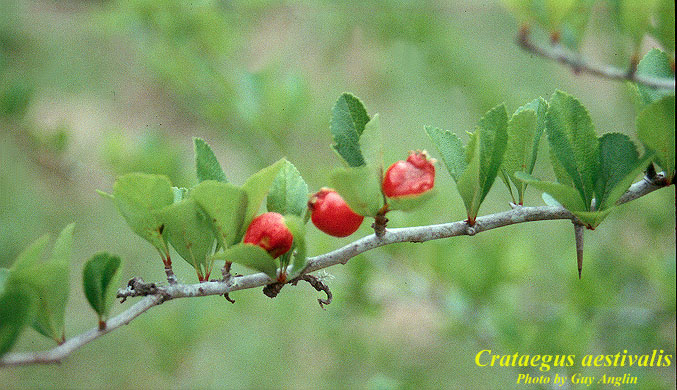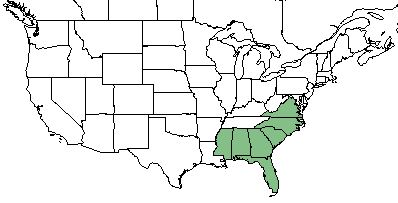Difference between revisions of "Crataegus aestivalis"
| Line 33: | Line 33: | ||
===Habitat=== <!--Natural communities, human disturbed habitats, topography, hydrology, soils, light, fire regime requirements for removal of competition, etc.--> | ===Habitat=== <!--Natural communities, human disturbed habitats, topography, hydrology, soils, light, fire regime requirements for removal of competition, etc.--> | ||
''C. aestivalis'' is most often found in swamp forests, generally where flooded for much of the year, often flowering and fruiting while standing in water, and occasionally growing as groves or stands in ‘mayhaw flats’.<ref name= "Weakley 2015"> Weakley, A. S. (2015). Flora of the Southern and Mid-Atlantic States. Chapel Hill, NC, University of North Carolina Herbarium. </ref> Also often found in deciduous woods.<ref name = "FSU herbarium"> URL: http://herbarium.bio.fsu.edu. Last accessed: June 2018. Collectors: Robert K. Godfrey, Angus Gholson, H. Kurz, Sidney McDaniel, R.A. Norris, Wilson Baker, Cecil R. Slaughter, Palmer Kinsler, Edith Ellen Lee-Smith. States and counties: Gadsden County Florida, Jackson County Florida, Leon County Florida, Flagler County Florida, Lafayette County Florida, Wakulla County Florida, Atkinson County Georgia, Early County Georgia, Thomas County Georgia, Baker County Florida, Bradford County Florida. </ref> | ''C. aestivalis'' is most often found in swamp forests, generally where flooded for much of the year, often flowering and fruiting while standing in water, and occasionally growing as groves or stands in ‘mayhaw flats’.<ref name= "Weakley 2015"> Weakley, A. S. (2015). Flora of the Southern and Mid-Atlantic States. Chapel Hill, NC, University of North Carolina Herbarium. </ref> Also often found in deciduous woods.<ref name = "FSU herbarium"> URL: http://herbarium.bio.fsu.edu. Last accessed: June 2018. Collectors: Robert K. Godfrey, Angus Gholson, H. Kurz, Sidney McDaniel, R.A. Norris, Wilson Baker, Cecil R. Slaughter, Palmer Kinsler, Edith Ellen Lee-Smith. States and counties: Gadsden County Florida, Jackson County Florida, Leon County Florida, Flagler County Florida, Lafayette County Florida, Wakulla County Florida, Atkinson County Georgia, Early County Georgia, Thomas County Georgia, Baker County Florida, Bradford County Florida. </ref> | ||
| + | |||
| + | Associated species: ''Taxodium distichum'', ''Nyssa aquatica'', ''Nyssa biflora'', and ''Planera aquatica''.<ref name= "Weakley 2015"/> | ||
===Phenology=== <!--Timing off flowering, fruiting, seed dispersal, and environmental triggers. Cite PanFlora website if appropriate: http://www.gilnelson.com/PanFlora/ --> | ===Phenology=== <!--Timing off flowering, fruiting, seed dispersal, and environmental triggers. Cite PanFlora website if appropriate: http://www.gilnelson.com/PanFlora/ --> | ||
Revision as of 14:56, 22 April 2019
Common name: May Hawthorn[1]; Mayhaw; Eastern Mayhaw[2]
| Crataegus aestivalis | |
|---|---|

| |
| Photo by the Atlas of Florida Plants Database | |
| Scientific classification | |
| Kingdom: | Plantae |
| Division: | Magnoliophyta - Flowering plants |
| Class: | Magnoliopsida - Dicots |
| Order: | Rosales |
| Family: | Rosaceae |
| Genus: | Crataegus aestivalis |
| Species: | C. aestivalis |
| Binomial name | |
| Crataegus aestivalis Walter | |

| |
| Natural range of Crataegus aestivalis from USDA NRCS Plants Database. | |
Contents
Taxonomic Notes
Synonyms: none
Varieties: none
Description
C. aestivalis is a perennial tree/shrub of the Rosaceae family native to North America.[1]
Distribution
C. aestivalis is common in the southeastern corner of the United States, from Mississippi to Virginia.[1]
Ecology
Habitat
C. aestivalis is most often found in swamp forests, generally where flooded for much of the year, often flowering and fruiting while standing in water, and occasionally growing as groves or stands in ‘mayhaw flats’.[2] Also often found in deciduous woods.[3]
Associated species: Taxodium distichum, Nyssa aquatica, Nyssa biflora, and Planera aquatica.[2]
Phenology
C. aestivalis has been observed to flower in February, March, and May. [4]
Fire ecology
C. aestivalis is not fire resistant, and has a low fire tolerance.[1]
Use by animals
C. aestivalis is highly palatable to browsing animals, not highly palatable to grazing animals, and not palatable to humans.[1]
Conservation and Management
Cultivation and restoration
Photo Gallery
References and notes
- ↑ 1.0 1.1 1.2 1.3 1.4 USDA Plant Database https://plants.usda.gov/core/profile?symbol=CRAE
- ↑ 2.0 2.1 2.2 Weakley, A. S. (2015). Flora of the Southern and Mid-Atlantic States. Chapel Hill, NC, University of North Carolina Herbarium.
- ↑ URL: http://herbarium.bio.fsu.edu. Last accessed: June 2018. Collectors: Robert K. Godfrey, Angus Gholson, H. Kurz, Sidney McDaniel, R.A. Norris, Wilson Baker, Cecil R. Slaughter, Palmer Kinsler, Edith Ellen Lee-Smith. States and counties: Gadsden County Florida, Jackson County Florida, Leon County Florida, Flagler County Florida, Lafayette County Florida, Wakulla County Florida, Atkinson County Georgia, Early County Georgia, Thomas County Georgia, Baker County Florida, Bradford County Florida.
- ↑ Nelson, G. PanFlora: Plant data for the eastern United States with emphasis on the Southeastern Coastal Plains, Florida, and the Florida Panhandle. www.gilnelson.com/PanFlora/ Accessed: 18 MAY 2018